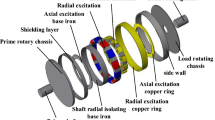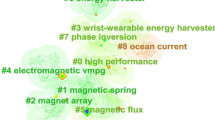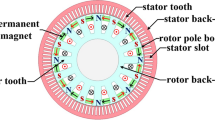Abstract
Specific to a problem that the present transmission of magnetic coupling torque was subjected to restrictions of its own structure, a hybrid magnetic coupling was proposed. Then, finite element method was adopted to carry out numerical calculations for its three-dimensional magnetic field to obtain three-dimensional magnetic field distribution of radial and axial configurations. Major influencing factors of its torque, such as lengths of axial and radial air gaps, thicknesses of axial and radial permanent magnets, the number of slots in axial copper rotor, thickness of axial and radial copper rotor, etc., were analyzed. The relevant results indicated that in certain conditions of shapes, ten magnetic poles of the axial permanent magnet rotor, nine of the radial permanent magnet rotor and nine slots from the axial copper rotor were used. Correspondingly, the axial copper rotor had a thickness of 20 mm and it was 5 mm for the radial copper rotor. Moreover, the maximum torque could reach 190 N.m approximately. If lengths of axial and radial air gaps increased, the torque may go down otherwise. Within a certain scope, the torque rose in the first place and then fell with increases in the permanent magnet thickness of axial permanent magnetic rotor, the number of axial and radial magnetic poles, the number of slots in axial copper rotor, and the thickness of axial copper rotor. Additionally, the number of slots in the axial copper rotor could not be equivalent to that of magnetic poles in axial permanent magnetic rotor. However, as the permanent magnet thickness of radial permanent magnetic rotor rose, the torque went up as well.



















Similar content being viewed by others
References
Kang, H. B., Choi, J. Y., & Cho, H. W. (2014). Comparative study of torque analysis for synchronous permanent magnet coupling with parallel and halbach magnetized magnets based on analytical field calculations. IEEE Transactions on Magnetics, 50(11), 1–4.
Min, K. C., Kang, H. B., & Park, M. G. (2014). Eddy current loss analysis in radial flux type synchronous permanent magnet coupling using space harmonic methods. Transactions of the Korean Institute of Electrical Engineers, 63(10), 1377–1383.
Hayat, T., Muhammad, T., Alsaedi, A., et al. (2015). Magnetohydrodynamic three-dimensional flow of viscoelastic nanofluid in the presence of nonlinear thermal radiation. Journal of Magnetism and Magnetic Materials, 385, 222–229.
Hayat, T., Muhammad, T., Shehzad, S. A., et al. (2015). Interaction of magnetic field in flow of maxwell nanofluid with convective effect. Journal of Magnetism and Magnetic Materials, 389, 48–55.
Chauhan, S., Kumari, S., Kumar, K., et al. (2015). Influence of iso-perthiocyanic acid and temperature on the aggregation properties of sodium dodecylsulphate in dimethyl sulphoxide. Journal of Molecular Liquids, 211, 338–345.
Hayata, T., Muhammada, T., Shehzad, S. A., et al. (2016). Modeling and analysis for hydromagnetic three-dimensional flow of second grade nanofluid. Journal of Molecular Liquids, 221, 93–101.
Hayat, T., Muhammad, T., Shehzad, S. A., et al. (2016). On three-dimensional boundary layer flow of Sisko nanofluid with magnetic field effects. Advanced Powder Technology, 27(2), 504–512.
Hayata, Tasawar, Aziza, Arsalan, Muhammad, Taseer, et al. (2016). On magnetohydrodynamic three-dimensional flow of nanofluid over a convectively heated nonlinear stretching surface. International Journal of Heat and Mass Transfer, 100, 566–572.
Kim, T. J., Hwang, S. M., & Park, N. G. (2000). Analysis of vibration for permanent magnet motors considering mechanical and magnetic coupling effects. IEEE Transactions on Magnetics, 36(4), 1346–1350.
Kim, J. M., Choi, J. Y., & Koo, M . M. (2016). Characteristic analysis of tubular-type permanent-magnet linear magnetic coupling based on analytical magnetic field calculations. IEEE Transactions on Applied Superconductivity, 26(4), 1–5.
Lyubimov, D. V., & Burnysheva, A. V. (2010). Rotating magnetic field effect on convection and its stability in a horizontal cylinder subjected to a longitudinal temperature gradient. Journal of Fluid Mechanics, 664(6), 108–137.
Pels, A., Bontinck, Z., & Corno, J. (2015). Optimization of a stern-gerlach magnet by magnetic field-circuit coupling and isogeometric analysis. IEEE Transactions on Magnetics, 51(12), 1–7.
Budhia, M., Boys, J. T., & Covic, G. (2013). Development of a single-sided flux magnetic coupler for electric vehicle IPT charging systems. IEEE Transactions on Industrial Electronics, 60(1), 318–328.
Mohammadi, S., Mirsalim, M., & Vaez-Zadeh, S. (2014). Analytical modeling and analysis of axial-flux interior permanent-magnet couplers. IEEE Transactions on Industrial Electronics, 61(11), 5940–5947.
Sun, Z., Zhou, L., & Wang, X. (2015). Magnetic field analysis and characteristics research of cylindrical permanent magnet adjustable speed drive. China Mechanical Engineering, 26(13), 1742–1746.
Baron, Yuri M. (2016). Magnetic abrasive deburring technology for blanks. International Journal of Engineering Research in Africa, 25, 1–10.
Yan, L., Chen, I. M., & Lim, C. K. (2011). Hybrid torque modeling of spherical actuators with cylindrical-shaped magnet poles. Mechatronics, 21(1), 85–91.
Ramana Reddy, J. V., Sugunamma, V., & Sandeep, N. (2016). Thermo diffusion and hall current effects on an unsteady flow of a nanofluid under the influence of inclined magnetic field. International Journal of Engineering Research in Africa, 20, 61–79.
Selvaggi, J. P., Salon, S., & Kwon, O. M. (2007). Computation of the three-dimensional magnetic field from solid permanent-magnet bipolar cylinders by employing toroidal harmonics. IEEE Transactions on Magnetics, 43(10), 3833–3839.
Janka, Mihalcová, & Miroslav, Rimár. (2015). Control of activity of aircraft engines by analysis of wear debris particles in terms of shape and size. International Journal of Engineering Research in Africa, 18, 136–143.
Acknowledgements
This research work was supported by the Emergency Management of National Natural Science Fund Project (Grant No. 41542002), the Natural science research project of Anhui University (Grant No. KJ2016A199) and Doctoral Fund of Ministry of Education of China (Grant No. 20133415110003).
Author information
Authors and Affiliations
Corresponding author
Rights and permissions
About this article
Cite this article
Wang, S., Guo, Yc., Wang, Py. et al. Study on Torque Calculation for Hybrid Magnetic Coupling and Influencing Factor Analysis. 3D Res 8, 1 (2017). https://doi.org/10.1007/s13319-016-0112-9
Received:
Revised:
Accepted:
Published:
DOI: https://doi.org/10.1007/s13319-016-0112-9




